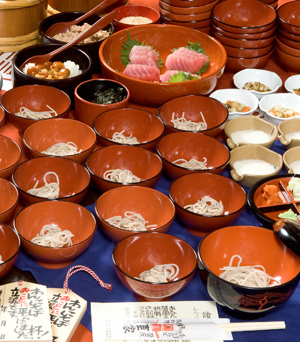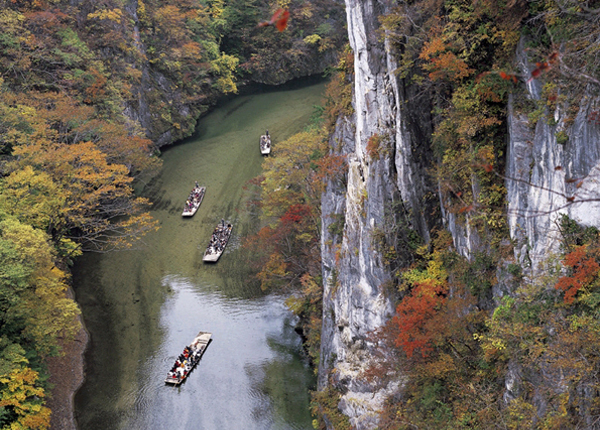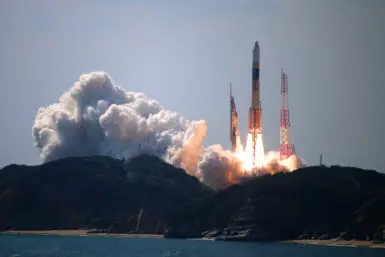Travelling to Iwate in the autumn is a great idea – especially if you are a fan of nature, history and culture. The northern prefecture has so much to offer.
If you have never made the relatively short trip from Tokyo to Iwate – the prefectural capital, Morioka, is just over a couple of hours by train – then October, with nature’s autumnal colours at their most vivid, is perfect. If you wait, you may hit the ski season or the Iwate Snow Festival, but whenever you are there, be sure to try the noodles. We visited Iwate to have a look at some of its highlights.
Ryusendo Caves
Surrounded by a calm forest of beech and oak trees, the underground caves and lakes of Ryusendo are located beneath Mt. Ureira, a two hour bus journey from Morioka.
The complex maze of caves – which visitors can enter from the Ryusenshindo Science Museum, next to the Ryusendo Onsen Hotel – were discovered in 1967 and are officially designated as a natural treasure of Japan.
Exploring the deep passageways carved into the limestone, with mystifying stalactites and stalagmites, it is easy to see why.
Amongst the caves are a number of deep underground lakes, one of which is considered – at 120 meters – the deepest in Japan and one of the clearest in the world. Taking a 30-minute tour through the tunnels and along specially made platforms around them is a unique experience.
Underwater lights give the walls of the caves and the emerald green water a special glow, enveloping the entire area with a mystical atmosphere.
Chusonji in Hiraizumi
Hiraizumi features five UNESCO-designated sites of historical interest and the encompassing temples and gardens, the 11th- and 12th-century buildings and surrounding areas are worth their place.
Chusonji Temple is one of the oldest in the area, having been founded in 850. Perhaps the most well known part of the complex is Konjikido (Golden Hall), which, similar to the famous Kinkakuji in Kyoto, is almost completely covered with gold.
If you fancy a good walk you could cover a lot of ground on foot but the main attractions are fairly widely spread so renting a bicycle is about the best way to go – especially if you enjoy riding through the forest and enjoying nature as you go.
Many of the slightly further apart attractions are covered by local tour buses – particularly the local ‘Hiraizumi “Run Run” Loop Bus’ – which connects Hiraizumi Station with all the sites of interest in central Hiraizumi.
Geibikei Gorges (pictured top), one of the outlying attractions, may even call for a car. If you do make that trip you will not be disappointed. Take a spectacular boat ride down a shallow river that runs between cliffs as tall as 100 meters and enjoy in the scenery which, in any season, is incredible. The autumn hues particularly bring many people to the area.
 Wanko Soba
Wanko Soba
Finish a bowl and you’ll get another. And another, and another. The noodles will keep coming until you can eat no more, mouthful-sized portions flung into your dish by your server who, according to legend, is mimicking the hospitality of years gone by when landowners would feel proud to stuff their guests to satisfaction.
Whether you see it as a time honoured tradition or simply a slurp-worthy wanko soba challenge with friends, this is one aspect of Iwate cuisine we particularly love.
Koiwai Farm
The lush green meadow-like fields of Koiwai Farm at the foot of Mt. Iwate seem like a world away from Tokyo and their huge expanse has much to offer.
Its 100-year past as a working farm is reflected in an exhibition hall at the heart of the park, near the Koiwai Dairy Factory complex and the pastoral Makiba-en, at which you might learn a little more about the agricultural history of the area and where the milk in your coffee comes from.
Hiking, nature walks, horse riding, archery and many other activities may give you a hunger for some local creamy goodness and you might even check out the Makiba Astronomical Observatory, where you can observe sunspots by day and an expanse of stars Tokyoites can only dream about by night. In winter, entrance to Makiba-en, which also hosts the popular Iwate Snow Festival, is free.
Find more information at www.koiwai.co.jp/makiba/en/
Words by Matthew Holmes










